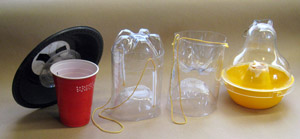How to Trap Spotted Wing Drosophila
 |
|
The red cup trap, two bottle traps, and the Trappit trap. Source: R. Cowles, Connecticut Agricultural Experiment Station |
For monitoring purposes, the commercial baits available through Trécé perform very well. For mass trapping, such an attractant would be prohibitively expensive. Homemade kombucha as a liquid bait has many advantages, including its low cost.
The bottle trap is a major advance over the cup trap. Starting materials are inexpensive, the trap is relatively easy to make, and having the opening at the bottom of the trap will be compatible with use of insecticide and sugar baited sprays in an attract-and-kill program.
The two-liter bottle trap with the small head space is statistically indistinguishable in trap efficiency from the Trappit design, which costs about $12 per trap. The material cost for the bottle trap is about $0.07 per trap, and it takes five to ten minutes to convert a two-liter bottle into such a trap.
A mesh with three millimeter openings will exclude larger insects from entering the trap. This reduces the trap catch by about fifty percent; since the trap could be used with insecticides, the number of flies removed in total would not be compromised. Assessing the trap contents certainly is easier without the large insects.
How to Make Kombucha
To make kombucha, the starting materials are water, sugar, white vinegar, and a SCOBY (symbiotic community of bacteria and yeast) that can be inexpensively obtained online. An adequate recipe for kombucha is to use 4 cups of sugar added to 4 gallons of extremely hot water in a 5 gallon bucket. Cover (butcher paper or newspaper) while the mixture cools. Once cool, add 1 fluid ounce (30 ml, or 2 tbsp) of white vinegar, and then add the SCOBY to start the fermentation. Cover the bucket, and hold in a warm location for one to two weeks. At the end of this period, the kombucha should be effervescent and have an aroma reminiscent of apple cider that has started fermenting. Be sure, if you transfer the kombucha to plastic jugs, to leave the lid loose so that the bottle will not explode. At a cost of about $1 per gallon for an attractant that can last two or more weeks, kombucha will be very difficult to beat.
How to Make the Two-Liter Bottle Trap
The bottle trap is a major advance over the cup trap. Starting materials are inexpensive, the trap is relatively easy to make, and having the opening at the bottom of the trap will be compatible with use of insecticide and sugar baited sprays in an attract-and-kill program.
To make the bottle trap, cut the top of a two-liter bottle so that you have an opening 3.5 cm in diameter. Push the top of the bottle into the interior of the bottle, until the cut edge is 6 cm on the inside of the trap. Cut the bottle 6 cm from the bottom. Take the bottom portion of the bottle, and using a hole punch, make two holes on opposite sides. These holes will be used for hanging the trap on a string. Insert a 50 cm length of string through the holes, and tie a 2 cm length of small diameter dowel to each end of the string. When using this trap, partially fill the bait reservoir with kombucha or a 60:40 mixture of red wine and vinegar. Insert what used to be the bottom of the bottle into the top of the trap, so that there is only about a 1–2 cm space between the opening into the trap, and the “ceiling” of the space inside the trap. Use tape of any sort to hold the two parts together, and hang the string over a branch of a blueberry or raspberry plant so that the trap will mostly be kept in the shade. The upper part of the trap will form a second reservoir that may retained rain water, which may improve attraction of SWD to the trap.
Source: Richard Cowles, Connecticut Agricultural Experiment Station
The Northeastern IPM Center promotes integrated pest management for reducing risks to human health and the environment. If republishing our news, please acknowledge the source (“From Northeast IPM Insights”) along with a link to our website.
